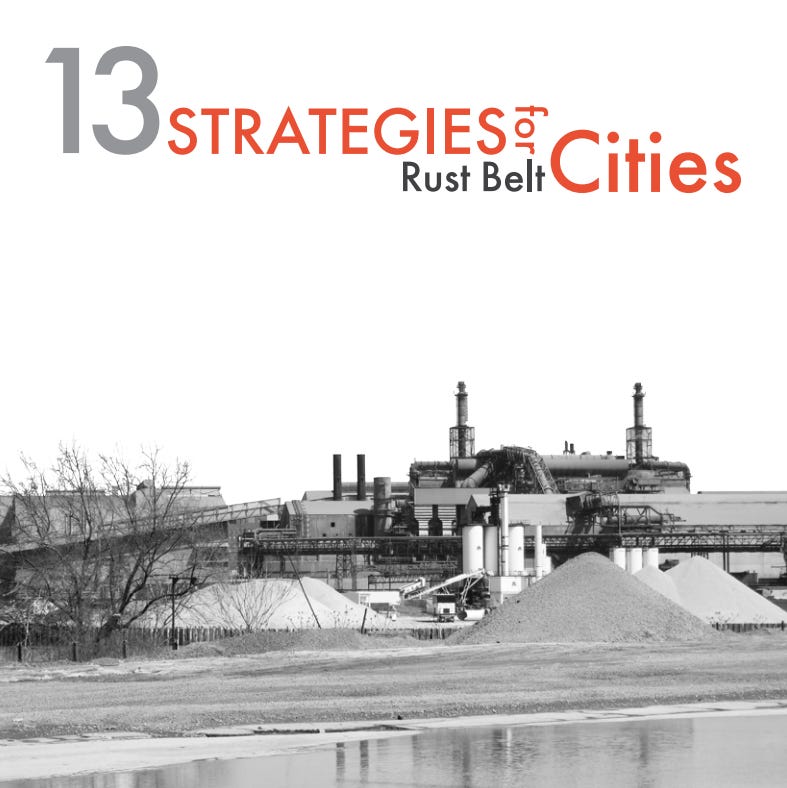Diamonds in the rust: a CRP Rust Belt study
Seeing the beauty of Great Lakes’ post-industrial cities, 13 CRP grad. students started "Diamonds in the Rust." Read the story, by Melissa Lindsjo and Liz Colombo from Issue 4, Spring 2012.
While many paint the Rust Belt with a broad brush of economic disaster, there is much to be hopeful about. “Rust Belt” is a term, often used negatively, to refer to the Great Lakes mega region’s older industrial cities, including cities such as Cleveland, Detroit, Youngstown, Cincinnati, along with cities as far from Columbus as Buffalo and St. Louis. These once powerful industrial cities have been hit hard by the decline of manufacturing and are known widely for population decline and disinvestment. According to the Brookings Institution’s report The Re-Emergence of Concentrated Poverty: Metropolitan Trends of the 2000s, the Rust belt has some of the nation’s worst concentrated poverty rates, which is telling not only of poverty but also unemployment, inequality, and an overall lack of opportunity. Toledo experienced the most significant increase in concentrated poverty of any metropolitan area in the country, while both Detroit and Cleveland have concentrated poverty rates nearing 25%.
Of course, the positive trends are less well-known. For example, Youngstown has been recognized as one of the best cities in the country to be an entrepreneur, St. Louis’ downtown is the fastest-growing residential neighborhood in its region, and Pittsburgh is topping lists of most livable cities. In cities that have experienced such intense disinvestment, these accolades are not accidents but rather the result of successful risk-taking in policy making. Consequently, a kind of “Rust Belt Chic” has begun to emerge; the term Rust Belt is becoming a badge of honor, signifying these cities’ grittiness and determination to survive. This attention can help the region capitalize on its assets if policymakers are willing to embrace it.
These possibilities of Rust Belt cities have inspired thirteen City and Regional Planning graduate students from The Ohio State University to participate in its revitalization. With great pride and hope for Rust Belt cities (many of us are from them), we have begun an initiative titled “Diamonds in the Rust,” which celebrates the beauty of Great Lakes’ post-industrial cities, but also champions innovative strategies that we are developing to address the admittedly vast set of issues facing the Rust Belt.
We are spending the 2011-2012 academic year collaborating, exploring the challenges of Rust Belt cities, and developing proposals to address them. We will research planning strategies from around the region, nation, and world that address economic and community development, quality of life, sustainability, and regional cooperation, and will adapt them to specific issues of the Rust Belt.
The “Diamonds in the Rust” initiative spent Autumn quarter conducting research and has developed proposals that range from an economic development plan for Warren, Ohio to capitalize strategically on local shale, a downtown trial living program modelled after a program in Görlitz, Germany, a plan to attract immigrant populations to Cleveland as a means for neighborhood revitalization, and a branding plan for the Rust Belt influenced by the grit, history, and success of the area that showcases the young professionals who are making these cities their home and future.
Winter and Spring quarters will be spent writing and designing a single “Diamonds in the Rust” publication that contains each of our proposed solutions. We will also be taking a Spring Break trip to a number of Rust Belt cities and documenting these experiences with videos. These will be chronicled on a “Diamonds in the Rust” website we hope to have up by the end of February that will include blog posts, videos and pictures.
Past Issues
This article is a part of One:Twelve’s “From the Archives” series, selecting some of our favorite pieces since the magazine’s start in 2010.







